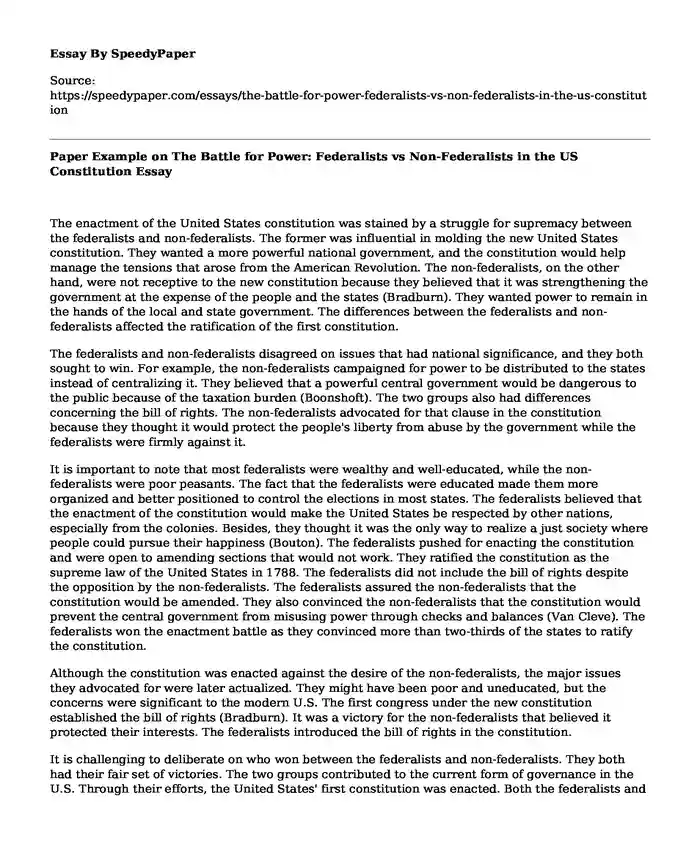
| Type of paper: | Essay |
| Categories: | United States Government Constitution |
| Pages: | 3 |
| Wordcount: | 658 words |
The enactment of the United States constitution was stained by a struggle for supremacy between the federalists and non-federalists. The former was influential in molding the new United States constitution. They wanted a more powerful national government, and the constitution would help manage the tensions that arose from the American Revolution. The non-federalists, on the other hand, were not receptive to the new constitution because they believed that it was strengthening the government at the expense of the people and the states (Bradburn). They wanted power to remain in the hands of the local and state government. The differences between the federalists and non-federalists affected the ratification of the first constitution.
The federalists and non-federalists disagreed on issues that had national significance, and they both sought to win. For example, the non-federalists campaigned for power to be distributed to the states instead of centralizing it. They believed that a powerful central government would be dangerous to the public because of the taxation burden (Boonshoft). The two groups also had differences concerning the bill of rights. The non-federalists advocated for that clause in the constitution because they thought it would protect the people's liberty from abuse by the government while the federalists were firmly against it.
It is important to note that most federalists were wealthy and well-educated, while the non-federalists were poor peasants. The fact that the federalists were educated made them more organized and better positioned to control the elections in most states. The federalists believed that the enactment of the constitution would make the United States be respected by other nations, especially from the colonies. Besides, they thought it was the only way to realize a just society where people could pursue their happiness (Bouton). The federalists pushed for enacting the constitution and were open to amending sections that would not work. They ratified the constitution as the supreme law of the United States in 1788. The federalists did not include the bill of rights despite the opposition by the non-federalists. The federalists assured the non-federalists that the constitution would be amended. They also convinced the non-federalists that the constitution would prevent the central government from misusing power through checks and balances (Van Cleve). The federalists won the enactment battle as they convinced more than two-thirds of the states to ratify the constitution.
Although the constitution was enacted against the desire of the non-federalists, the major issues they advocated for were later actualized. They might have been poor and uneducated, but the concerns were significant to the modern U.S. The first congress under the new constitution established the bill of rights (Bradburn). It was a victory for the non-federalists that believed it protected their interests. The federalists introduced the bill of rights in the constitution.
It is challenging to deliberate on who won between the federalists and non-federalists. They both had their fair set of victories. The two groups contributed to the current form of governance in the U.S. Through their efforts, the United States' first constitution was enacted. Both the federalists and non-federalists had definite opinions concerning the constitution, which have gradually been accomplished after enacting the constitution. They both agreed that the inclusion of the bill of rights in the constitution was important. Conclusively, the differences between the federalists and non-federalists were the foundation of the democracy that exists in U.S. politics.
Works Cited
Boonshoft, Mark. "Doughfaces at the Founding: Federalists, Anti-Federalists, Slavery, And The Ratification Of The Constitution In New York." New York History, 2020, http://dx.doi.org/10.2307/newyorkhist.93.3.187.
Bouton, Terry. "Ratification: The People Debate The Constitution, 1787–1788 By Pauline Maier". Journal Of The Early Republic, 2020, http://dx.doi.org/10.1353/jer.2014.0077.
Bradburn, D. "Ratification: The People Debate the Constitution, 1787-1788". Journal Of American History, 2020, http://dx.doi.org/10.1093/jahist/jar627.
Van Cleve, George William. "The Anti-Federalists’ Toughest Challenge: Paper Money, Debt Relief, And The Ratification Of The Constitution." Journal Of The Early Republic, 2020, http://dx.doi.org/10.1353/jer.2014.0063.
Cite this page
Paper Example on The Battle for Power: Federalists vs Non-Federalists in the US Constitution. (2023, Nov 29). Retrieved from https://speedypaper.com/essays/the-battle-for-power-federalists-vs-non-federalists-in-the-us-constitution
Request Removal
If you are the original author of this essay and no longer wish to have it published on the SpeedyPaper website, please click below to request its removal:
- Essay Example: Aid Organization Report
- Essay Example about the Decline of Labor Unions in the United States
- Essay Sample on Philosophy of the Law
- Essay Sample on Prohibition in the 1920s
- Walmart: America's Favorite Shopping Destination - Paper Sample
- Critical Infrastructure - Free Essay Sample
- Free Paper Sample: President Trump - Four More Years
Popular categories




